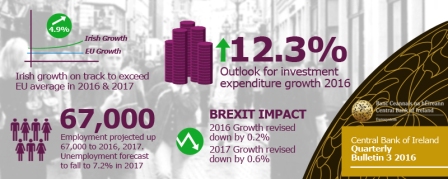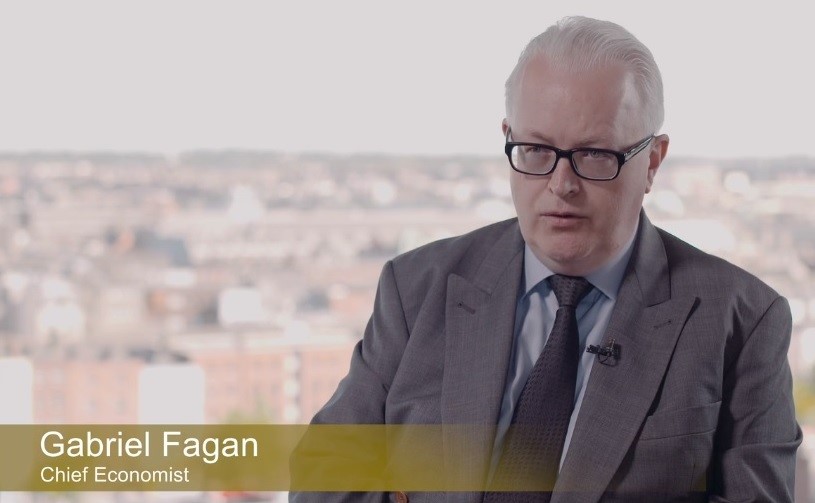Quarterly Bulletin No.3 July 2016
06 December 2016
Quarterly Bulletin
Quarterly Bulletin No.3 2016 was published on 27 July 2016.

Read the full Quarterly Bulletin No.3 2016 (PDF 4.68MB).
Watch the launch of the Quarterly Bulletin on our YouTube channel.
Read the Quarterly Bulletin No. 3 2016 Quarterly Bulletin No. 3 2016 press conference transcript (PDF 208.22KB).
Access the individual sections and watch our economists discuss the Quarterly Bulletin below.
(PDF 30.15KB)
Tá leagan Gaeilge den
Timpeallacht Gheilleagrach (PDF 31.62KB) ar fáil anseo.

Click on the image to watch Chief Economist Gabriel Fagan discuss Quarterly Bulletin No. 3 of 2016. Alternatively, watch the video on our YouTube channel.
Domestic Economy
A level shift in recorded productive capacity of the Irish economy in 2015 was reflected in an upward revision to GDP growth from 7.8 per cent to 26.3 percent. The underlying pace in growth of about 5 per cent in 2015 is likely to moderate over the next two years with projected GDP growth of about 4.9 per cent in 2016 and 3.6 per cent in 2017. This downward revision to the outlook reflects the impact of British exit from the European Union and some moderation in external demand generally. Notwithstanding these revisions, Irish GDP growth is likely to exceed the EU average by a significant margin both this year and next.
Read the full chapter:
Domestic Economy (PDF 835.27KB).
Financing Developments in the Irish Economy
Financing conditions in the Irish economy have continued to improve since publication of the last Quarterly Bulletin. Economic growth, alongside an accommodative monetary policy stance at the European Central Bank, has resulted in a strengthened funding position for financial and non-financial firms. Deposits with Irish resident credit institutions grew marginally during the first five months of 2016, with strong inflows recorded for the non-financial corporation sector. Irish households continued to be net funders of the Irish banking system at end-May with deposits outstripping loans by some €6.4 billion.
Read the full chapter:
Financing Developments in the Irish Economy (PDF 1.04MB)
Developments in the Euro Area Economy
The euro area continues to recover and Inflation turned positive in June – albeit at 0.1% y-o-y – and is expected to increase further. The principal risk overshadowing the euro area’s recovery is the decision by the U.K. to leave the EU (Brexit) and the uncertain political and economic arrangements that will be reached between both entities. Additionally, the high level of non-performing loans across the euro area’s banking sector acts as a drag on the recovery.
Cash buyers have been the focus of much comment recently. We address this theme and find that the term cash buyer relates to non-mortgage transactions. Such transactions accounted for 60 per cent of all recent activity. This reflects investment opportunities plus low levels of construction and mortgages drawn down since the financial crisis. We find that there is an absence of clear data for the years before 2010. We also find that the composition of cash buyers has changed.
Read the full signed article:
Estimating Cash Buyers and Transaction Volumes in the Residential Property Sector in Ireland, 2000-2014 (PDF 382.52KB).
The New Paradigm: Analysis of Eurosystem Monetary Operations
by John Graham, Alaoishe Luskin and Anthony Nolan
This article reviews the Eurosystem’s operational framework over the period 2015 and H1 2016. It outlines the main changes to the framework, in particular the expansion of the asset purchase programmes, and analyses the impact of these measures on Eurosystem liquidity provision and on liquidity conditions. The article also summarises developments in the euro-area money market and provides a summary of the debt capital market activity of both the Irish sovereign and main domestic banks.